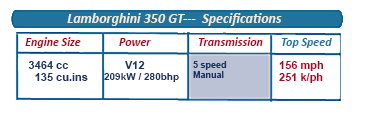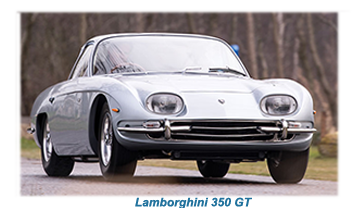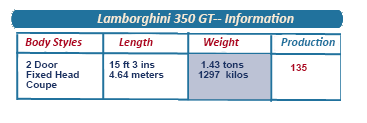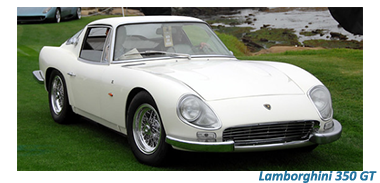
Like so many models that were to follow, the first Lamborghini, the 350 GT made its debut at a Geneva Motor Show, this one in 1964.
Ferruccio Lamborghini, who already built up a considerable business empire, went into the market convinced that he could compete with some of the most beautiful touring cars of the decade, if not the century from market leaders in the US, UK and particularly from his two main Italian rivals, Ferrari and Maserati.
Lamborghini had a particular ace up his sleeve with the 350GT, designed by the talented Giotto Bizzarrini, who had worked for Alfa Romeo and Ferrari where he was the lead designer on the classic 250GTO.
had a particular ace up his sleeve with the 350GT, designed by the talented Giotto Bizzarrini, who had worked for Alfa Romeo and Ferrari where he was the lead designer on the classic 250GTO.
Bizzami caught Ferruccio Lamborghini eye for his work on a Formula 1 single-seater and a GT sports car, the ATS Serenissima, powered by a 1.5-litre V8 engine.
Lambo rghini wasted little time in commissioning Giotto Bizzarrini to design and produced a larger road car engine on similar lines, with the first completed in May 1963.
rghini wasted little time in commissioning Giotto Bizzarrini to design and produced a larger road car engine on similar lines, with the first completed in May 1963.
In its original 3.5 litre format, the prototype produced more than 350bhp during initial tests.
A twin-overhead camshaft unit, the Lamborghini engine was more advanced than Ferrari's production single overhead camshaft V12s.
Rather than instal a fuel injection system, Lamborghini fitted six Weber twin-choke carburettors to boost power.
This appea red to be an overly daunting challenge, but Lamborghini were confident that once correctly set up, the Webers would not be in need of adjustment outside routine maintenance intervals.
red to be an overly daunting challenge, but Lamborghini were confident that once correctly set up, the Webers would not be in need of adjustment outside routine maintenance intervals.
According to early tests on the 350GT held in the Autumn of 1963, this engine was rated capable of generating 360bhp at 8000rpm, although for the production version it was detuned,
Lamborghini wanted a tractable, smooth and lightly stressed road car engine, not a racing unit. In this form, the GT350 was rated at 270bhp at 6500rpm.
Despite hopes to the contrary, Bizzarrini's cooperation with Lamborghini ended at the time of the launch.
The genius designer was looking for recognition as well as new commissions.
The reputation earned by his work ong thr 350GT allowed him to make a few more cars carrying his name.
In restospect Bizzarrini's contribution to Lamborghini was almost immeasurable, leaving them with a superb engine, later used in a number of other models.
The 350GT was a superb performer, with the magnificent engine delivering brutal acceleration and an awesome top speed.
![]()
The 350GT offered almost perfect handling thanks to independent suspension all round, meaning thatroad-holding was tenacious, and power-assisted Girling disc brakes stopped it.
In the 350GT's specification were some of the sophisticated ingredients Lamborghini felt necessary if his company was to compete with Ferrari, notably independent suspension all round, by wishbones and coil springs, disc brakes front and rear, ZF steering and a ZF 5-speed gearbox.
 The steel t
The steel t ube chassis echoed racing practices and was clothed in a body that was sleek but not well balanced in conception.
ube chassis echoed racing practices and was clothed in a body that was sleek but not well balanced in conception.
The 350GT's design was all about curving lines and sharp edges, there were retractable headlights, but also some odd details, and the six exhausts projecting under the tail just seemed flashy.
Parking lights were mounted above slim wrap-around bumperettes that covered a portion of the grille and extended a short distance into the fender sides.
Large triangular rear quarter windows were installed along with a big, tall back window. Rear wheel openings were squared-off, whereas fronts were rounded.
A bodyside crease extended from a curve just ahead of the front wheel along the front fender. and into the door.
![]()
The Lamborghini 350GT also set the bar for passenger comfort levels, with deep bucket seats faced well-trimmed leather and aluminium dashboard with Jaeger clocks and steel toggle switches.
Most bodies were semi-fastback coupes though a few convertibles were produced by particular order only by Touring.
UnfortunateLY , while the 350 GT was as technically advanced as any, its overall performance would prove to be a disappointment in many other ways.
, while the 350 GT was as technically advanced as any, its overall performance would prove to be a disappointment in many other ways.
Auto historians gradually reached the opinion that Lamborghini only developed the 350GT to show the motoring world the seriousness of their intentions to become a force in the luxury touring car sector.
Aftera slowish start the word got out, and production of the 350 GT grew at a steady pace through 1965 and into 1967 before it was phased out to be replaced by the 400GT.
Production of the original Lamborghini 350GT, with the 3464-cc engine, continued although 23 examples were produced with the larger 3929-cc engine, as was fitted in the 400 GT.






